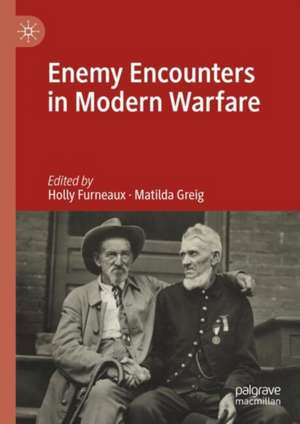Enemy Encounters in Modern Warfare
Editat de Holly Furneaux, Matilda Greigen Limba Engleză Hardback – 25 oct 2024
Preț: 815.04 lei
Preț vechi: 895.65 lei
-9% Nou
Puncte Express: 1223
Preț estimativ în valută:
155.95€ • 162.84$ • 128.78£
155.95€ • 162.84$ • 128.78£
Carte tipărită la comandă
Livrare economică 11-17 aprilie
Preluare comenzi: 021 569.72.76
Specificații
ISBN-13: 9783031567476
ISBN-10: 3031567471
Pagini: 400
Ilustrații: Approx. 400 p.
Dimensiuni: 148 x 210 mm
Ediția:2024
Editura: Springer International Publishing
Colecția Palgrave Macmillan
Locul publicării:Cham, Switzerland
ISBN-10: 3031567471
Pagini: 400
Ilustrații: Approx. 400 p.
Dimensiuni: 148 x 210 mm
Ediția:2024
Editura: Springer International Publishing
Colecția Palgrave Macmillan
Locul publicării:Cham, Switzerland
Cuprins
1: Introduction.- 2: Encounters with Peninsular War Guerrillas and the Marginalisation of Irregular Warfare.- 3: ‘He said he was an Irishman also’: Irish American Union and Confederate Encounter Stories in the American Civil War.- 4: Encountering the Enemy in Fin-de-siècle Colonial Wars: Racial Difference and the Limits of Fellow Feeling.- 5: Global Sexual Encounters with Racialized ‘Others’ in War, Genocide and Captivity, 1905-1945.- 6: ‘Yoors truly German’: A Micro-history of Poetic Enemy Encounters of the 1917 Retreat.- 7: Dying with the Enemy: Prisoner of War Deaths in First World War Britain.- 8: Racial Encounters in Wartime Post/Colonial Indo-Myanmar Borderlands.- 9: ‘Children Made to Carry Bombs’: Staging the ‘Emergency’ in Malaya (1948-60).- 10: Trusting Your Enemy: American Encounters with the Kit Carson Scouts During the Vietnam War, 1966–1973.- 11: Between ‘Nostalgia’ and ‘Self-Othering’: Self-Orientalism, Strategic Nostalgia and Self-Othering Practises in Islamic State Propaganda Imagery.- 12: Memorializing the Enemy Three Ways: Australia, Japan, the USA.- 13: Afterword.
Notă biografică
Holly Furneaux is Professor at Cardiff University, UK.
Matilda Greig is a Historian at the National Army Museum in London, UK.
Matilda Greig is a Historian at the National Army Museum in London, UK.
Textul de pe ultima copertă
“Rigorously researched and delicately textured, these essays are instructive for our times, making us think afresh about the varied and complex lives of ‘enemy encounters’, with their roots in geo-political histories and propaganda machineries on one hand and the innermost recesses of our psyche on the other.”
– Santanu Das, University of Oxford, UK
“A rich and interdisciplinary collection which blends historical and literary approaches into an original collaborative study of representations of enemy encounters in modern war. The volume’s historical scope sometimes reveals that very contemporary debates about, for instance, killing and emotion actually have echoes in pre-twentieth-century war.”
– Catherine Baker, University of Hull, UK
While the 1914 Christmas truces have a mythological status in British culture, intimate interactions with the enemy are, this interdisciplinary edited collection shows, a staple of modern warfare. Spanning multiple conflicts around the world, from the nineteenth century to the present Russia/Ukraine war, the chapters consider how fellow-feeling with the enemy during war has been both fueled and limited by constellations of class, gender, nationality, race, religion, sexuality, and shared experience. Scrutinizing asymmetries of power in enemy encounters, the instability of divisions between allies and enemies, and the heterogeneity of experiences within one army or side, contributors to this book confront a central question: how far is thinking of the enemy as an ‘equal’ in some way a precondition for non-violent interactions with them in war? In some cases, the ease of fraternization and reciprocity between the lines raises questions about the necessity of a clear feeling of enmity for fighting to continue, while in others, exclusionary attitudes based on racial or colonial hierarchies or the criminality of irregular warfare result in extreme violence and differential valuations of enemy lives.
Holly Furneaux is Professor at Cardiff University, UK.
Matilda Greig is a Historian at the National Army Museum in London, UK.
– Santanu Das, University of Oxford, UK
“A rich and interdisciplinary collection which blends historical and literary approaches into an original collaborative study of representations of enemy encounters in modern war. The volume’s historical scope sometimes reveals that very contemporary debates about, for instance, killing and emotion actually have echoes in pre-twentieth-century war.”
– Catherine Baker, University of Hull, UK
While the 1914 Christmas truces have a mythological status in British culture, intimate interactions with the enemy are, this interdisciplinary edited collection shows, a staple of modern warfare. Spanning multiple conflicts around the world, from the nineteenth century to the present Russia/Ukraine war, the chapters consider how fellow-feeling with the enemy during war has been both fueled and limited by constellations of class, gender, nationality, race, religion, sexuality, and shared experience. Scrutinizing asymmetries of power in enemy encounters, the instability of divisions between allies and enemies, and the heterogeneity of experiences within one army or side, contributors to this book confront a central question: how far is thinking of the enemy as an ‘equal’ in some way a precondition for non-violent interactions with them in war? In some cases, the ease of fraternization and reciprocity between the lines raises questions about the necessity of a clear feeling of enmity for fighting to continue, while in others, exclusionary attitudes based on racial or colonial hierarchies or the criminality of irregular warfare result in extreme violence and differential valuations of enemy lives.
Holly Furneaux is Professor at Cardiff University, UK.
Matilda Greig is a Historian at the National Army Museum in London, UK.
Caracteristici
Provides an intersectional exploration of the significance of race, gender, class and age in enemy encounters Reveals insights into a rarely discussed aspect of war spanning conflicts around the world from the nineteenth century Includes interdisciplinary approaches ranging from across the humanities, international relations and military studies
